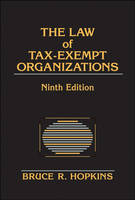
The Law of Tax-exempt Organizations
John Wiley & Sons Ltd (Verlag)
978-0-470-03760-7 (ISBN)
- Titel ist leider vergriffen;
keine Neuauflage - Artikel merken
Bruce R. Hopkins is the country's leading authority on tax-exempt organizations and is a lawyer with the firm Polsinelli, Shalton, Welte, P.C. He is also the author of nineteen books, including The Legal Answer Book for Private Foundations, The Legal Answer Book for Nonprofit Organizations; The Law of Tax-Exempt Organizations, 8E; Private Foundations: Tax Law and Compliance, 2E; A Legal Guide to Starting and Managing a Nonprofit Organization, 4E; and The Tax Law of Charitable Giving, 3E, as well as the newsletter Bruce Hopkins' Nonprofit Counsel, all published by Wiley.
Book Citations. PART ONE: INTRODUCTION TO THE LAW OF TAX-EXEMPT ORGANIZATIONS 1 Definition of and Rationales for Tax-Exempt Organizations. 1.1 Definition of Nonprofit Organization. 1.2 Definition of Tax-Exempt Organization. 1.3 Tax-Exempt Organizations Law Philosophy. 1.4 Political Philosophy Rationale. 1.5 Inherent Tax Rationale. 1.6 Other Rationales and Reasons for Exempt Organizations. 1.7 Freedom of Association Doctrine. 2 Overview of Nonprofit Sector and Tax-Exempt Organizations. 2.1 Profile of Nonprofit Sector. 2.2 Organization of IRS. 2.3 Charitable Contribution Deduction Rules. 2.4 Evolution of Statutory Scheme. PART TWO: FUNDAMENTALS OF THE LAW OF TAX-EXEMPT ORGANIZATIONS. 3 Source, Advantages, and Disadvantages of Tax Exemption. 3.1 Source of Tax Exemption. 3.2 Recognition of Tax Exemption. 3.3 Advantages of Tax-Exempt Status. 3.4 Disadvantages of Tax-Exempt Status. 3.5 Alternatives to Tax-Exempt Status. 4 Organizational, Operational, and Related Tests and Doctrines. 4.1 Forms of Tax-Exempt Organizations. 4.2 Governing Instruments. 4.3 Organizational Test. 4.4 Primary Purpose Test. 4.5 Operational Test. 4.6 Exclusively Standard. 4.7 Commensurate Test. 4.8 Consideration of Organizations' Names. 4.9 State Action Doctrine. 4.10 Operations for Profit. 4.11 Commerciality Doctrine. (a) Origin of Doctrine. 4.12 Social Enterprise Movement. 5 Boards of Directors and Governance Principles. 5.1 Boards of Directors Basics. 5.2 Board Composition and Tax Law. 5.3 Duties and Responsibilities. 5.4 Board Member Liability. 5.5 Sarbanes-Oxley Act. 5.6 Nonprofit Governance Principles. PART THREE: TAX-EXEMPT CHARITABLE ORGANIZATIONS. 6 Concept of Charitable. 6.1 Federal Tax Law Definition of Charitable. 6.2 Public Policy Doctrine. 6.3 Collateral Concepts. 7 Charitable Organizations. 7.1 Relief of Poor. 7.2 Relief of Distressed. 7.3 Credit Counseling. 7.4 Provision of Housing. 7.5 Down Payment Assistance. 7.6 Promotion of Health. 7.7 Lessening Burdens of Government. 7.8 Advancement of Education. 7.9 Advancement of Science. 7.10 Advancement of Religion. 7.11 Promotion of Social Welfare. 7.12 Promotion of Arts. 7.13 Consortia. 7.14 Instrumentalities of Government. 7.15 Other Categories of Charity. 8 Educational Organizations. 8.1 Federal Tax Law Definition of Educational. 8.2 Education Contrasted with Propaganda. 8.3 Educational Institutions. 8.4 Instruction of Individuals. 8.5 Instruction of Public. 8.6 Educational Activity as Commercial Business. 8.7 Educational Activity as Private Benefit Function. 8.8 Child Care Organizations. 9 Scientific Organizations. 9.1 Federal Tax Law Definition of Science. 9.2 Concept of Research. 9.3 Requirement of Public Interest. 9.4 Scientific as Charitable or Educational. 9.5 Technology Transfer. 10 Religious Organizations. 10.1 Constitutional Law Framework. 10.2 Federal Tax Law Definition of Religion. 10.3 Churches and Similar Institutions. 10.4 Conventions or Associations of Churches. 10.5 Integrated Auxiliaries of Churches. 10.6 Religious Orders. 10.7 Apostolic Organizations. 10.8 Communal Groups. 10.9 Retreat Facilities. 11 Other Charitable Organizations. 11.1 Cruelty Prevention Organizations. 11.2 Amateur Sports Organizations. 11.3 Public Safety Testing Organizations. 11.4 Cooperative Hospital Service Organizations. 11.5 Cooperative Educational Service Organizations. 11.6 Charitable Risk Pools. 11.7 Literary Organizations. 11.8 Donor-Advised Fund Entities. 12 Public Charities and Private Foundations. 12.1 Federal Tax Law Definition of Private Foundation. 12.2 Disqualified Persons. 12.3 Categories of Public Charities. 12.4 Private Foundation Rules. 12.5 Consequences of Private Foundation Status. PART FOUR: OTHER TAX-EXEMPT ORGANIZATIONS. 13 Social Welfare Organizations. 13.1 Concept of Social Welfare. 13.2 Requirement of Community. 13.3 Advocacy Organizations. 13.4 Comparison with Charitable Organizations. 14 Business Leagues and Like Organizations. 14.1 Concept of Business League. 14.2 Disqualifying Activities. 14.3 Chambers of Commerce. 14.4 Boards of Trade. 14.5 Real Estate Boards. 14.6 Nonexempt Membership Organizations. 15 Social Clubs. 15.1 Social Clubs in General. 15.2 Public Use Limitation. 15.3 Investment Income Limitation. 15.4 Exceptions to Limitations. 15.5 Taxation of Social Clubs. 15.6 Sale of Club Assets. 16 Labor, Agricultural, and Horticultural Organizations. 16.1 Labor Organizations. 16.2 Agricultural Organizations. 16.3 Horticultural Organizations. 17 Political Organizations. 17.1 Political Organizations in General. 17.2 Organizational Test. 17.3 Operational Test. 17.4 Public Policy Advocacy Activities. 17.5 Taxation of Political Organizations. 17.6 Taxation of Other Exempt Organizations. 17.7 Avoiding Political Organizations Tax. 17.8 Independent Political Action Committees. 18 Employee Benefit Funds. 18.1 Overview of Employee Benefits Law. 18.2 Special Rules for Welfare Benefit Funds. 18.3 Voluntary Employees' Beneficiary Associations. 18.4 Supplemental Unemployment Benefit Trusts. 18.5 Black Lung Benefits Trusts. 18.6 Retirement Plan Trust Funds. 18.7 Other Benefit Funds. 19 Other Tax-Exempt Organizations. 19.1 Instrumentalities of the United States. 19.2 Title-Holding Corporations. 19.3 Local Associations of Employees. 19.4 Fraternal Organizations. 19.5 Benevolent or Mutual Organizations. 19.6 Cemetery Companies. 19.7 Credit Unions. 19.8 Mutual Reserve Funds. 19.9 Insurance Companies and Associations. 19.10 Crop Operations Finance Companies. 19.11 Veterans' Organizations. 19.12 Farmers' Cooperatives. 19.13 Shipowners' Protection and Indemnity Associations. 19.14 Homeowners' Associations. 19.15 High-Risk Individuals Health Care Coverage Organizations. 19.16 Workers' Compensation Reinsurance Organizations. 19.17 Qualified Tuition Programs. 19.18 Professional Football Leagues. 19.19 Governmental and Quasi-Governmental Entities. 19.20 Native American Tribes. 19.21 Other Tax-Exempt Organizations. 19.22 Proposed Exempt Organizations. 19.23 Nonexempt Membership Organizations. PART FIVE: PRINCIPAL EXEMPT ORGANIZATION LAWS. 20 Private Inurement and Private Benefit. 20.1 Concept of Private Inurement. 20.2 Definition of Net Earnings. 20.3 Definition of Insider. 20.4 Compensation Issues. 20.5 Other Forms of Private Inurement. 20.6 Per Se Private Inurement. 20.7 Incidental Private Inurement. 20.8 Private Inurement and Social Welfare Organizations. 20.9 Private Inurement and Business Leagues. 20.10 Private Inurement and Social Clubs. 20.11 Private Benefit Doctrine. 21 Intermediate Sanctions. 21.1 Concept of Intermediate Sanctions. 21.2 Tax-Exempt Organizations Involved. 21.3 Disqualified Persons. 21.4 Transactions Involved. 21.5 Controlled Entities. 21.6 Intermediaries. 21.7 For the Use of Transactions. 21.8 Initial Contract Exception. 21.9 Rebuttable Presumption of Reasonableness. 21.10 Excise Tax Regime. 21.11 Correction Requirement. 21.12 Definitions. 21.13 Indemnification and Insurance. 21.14 Return for Payment of Excise Taxes. 21.15 Statute of Limitations. 21.16 Interrelationship with Private Inurement Doctrine. 22 Legislative Activities by Tax-Exempt Organizations. 22.1 Legislative Activities Law for Exempt Organizations-Introduction. 22.2 Meaning of Legislation. 22.3 Lobbying by Charitable Organizations. 22.4 Lobbying Expenditures and Tax Sanctions. 22.5 Legislative Activities of Social Welfare Organizations. 22.6 Legislative Activities of Business Leagues. 22.7 Legislative Activities of Other Tax-Exempt Organizations. 22.8 Internet Communications. 22.9 Constitutional Law Framework. 22.10 Federal Regulation of Lobbying. 23 Political Campaign Activities by Tax-Exempt Organizations. 23.1 Political Campaign Activities by Charitable Organizations-Introduction. 23.2 Prohibition on Charitable Organizations. 23.3 Political Campaign Expenditures and Tax Sanctions. 23.4 Taxation of Political Expenditures. 23.5 Political Activities of Social Welfare Organizations. 23.6 Political Activities by Labor Organizations. 23.7 Political Activities by Business Leagues. 23.8 Political Activities by Other Exempt Organizations. 23.9 Advocacy Communications. 23.10 Internet Communications. 23.11 Federal Election Law. 24 Unrelated Business Activities. 24.1 Introduction to Unrelated Business Rules. 24.2 Definition of Trade or Business. 24.3 Definition of Regularly Carried On. 24.4 Definition of Substantially Related. 24.5 Contemporary Applications of Unrelated Business Rules. 24.6 Modifications. 24.7 Exceptions. 24.8 Corporate Sponsorships. 24.9 Partnership Rules. 24.10 Special Rules. 24.11 Commercial-Type Insurance. 24.12 Unrelated Debt-Financed Income. 24.13 Tax Structure. 24.14 Deduction Rules. PART SIX: ACQUISITION AND MAINTENANCE OF TAX EXEMPTION. 25 Exemption Recognition and Notice Processes. 25.1 Recognition Application Procedure. 25.2 Requirements for Charitable Organizations. 25.3 Nonprivate Foundation Status. 25.4 Requirements for Certain Credit Counseling Organizations. 25.5 Requirements for Employee Benefit Organizations. 25.6 Group Exemption Rules. 25.7 Suspension of Tax Exemption. 25.8 Notice Requirements for Political Organizations. 25.9 Integral Part Doctrine. 25.10 Forfeiture of Tax-Exempt Status. 26 Administrative and Litigation Procedures. 26.1 Administrative Procedures Where Recognition Denied. 26.2 Revocation of Tax-Exempt Status: Litigation Procedures. 26.3 Retroactive Revocation of Tax-Exempt Status. 26.4 Tax Consequences of Retroactive Revocation of Exempt Status of Public Charities. 26.5 Third-Party Litigation. 26.6 IRS Examination Procedures and Practices. 27 Operational Requirements. 27.1 Changes in Operations or Form. 27.2 Annual Reporting Rules. 27.3 Small Organizations Notification Requirement. 27.4 Filing Requirements and Tax-Exempt Status. 27.5 Reporting by Political Organizations. 27.6 Electronic Filing Rules. 27.7 Unrelated Business Income Tax Returns. 27.8 IRS Document Disclosure Rules. 27.9 Document Disclosure Obligations of Exempt Organizations. 27.10 Information or Services Disclosure. 27.11 Fundraising Disclosure. 27.12 Insurance Activities. 27.13 Feeder Organizations. 27.14 Tax-Exempt Entity Leasing Rules. 27.15 Tax-Exempt Organizations and Tax Shelters. 27.16 International Grantmaking Requirements. 27.17 Record-Keeping Requirements. PART SEVEN: INTERORGANIZATIONAL STRUCTURES AND OPERATIONAL FORMS. 28 Tax-Exempt Organizations and Exempt Subsidiaries. 28.1 Subsidiaries Basics. 28.2 Charitable Organizations as Subsidiaries. 28.3 Tax-Exempt Subsidiaries of Charitable Organizations. 28.4 Other Combinations of Tax-Exempt Organizations. 28.5 Contributions and Other Payments. 28.6 Revenue from Tax-Exempt Subsidiary. 29 Tax-Exempt Organizations and For-Profit Subsidiaries. 29.1 For-Profit Subsidiaries in General. 29.2 Potential of Attribution to Parent. 29.3 Financial Considerations. 29.4 Asset Accumulations. 29.5 Subsidiaries in Partnerships. 29.6 Effect of For-Profit Subsidiaries on Public Charity Status. 29.7 Revenue from For-Profit Subsidiary. 29.8 Liquidations. 30 Tax-Exempt Organizations and Joint Ventures. 30.1 Partnerships and Joint Ventures Basics. 30.2 Public Charities as General Partners. 30.3 Whole-Entity Joint Ventures. 30.4 Ancillary Joint Ventures. 30.5 Low-Income Housing Ventures. 30.6 Information Reporting. 30.7 Alternatives to Partnerships. 31 Tax-Exempt Organizations and Restructuring. 31.1 Organizational Considerations. 31.2 Operational Considerations. 31.3 Mergers. 31.4 Limited Liability Company Law Basics. 31.5 Multiple-Member Limited Liability Companies. 31.6 Single-Member Limited Liability Companies. 31.7 Conversion from Exempt to Nonexempt Status. 31.8 Conversion from Nonexempt to Exempt Status. Epilogue. Appendixes. A. Sources of the Law. B. Internal Revenue Code Sections. C. 72 Categories of Tax-Exempt Organizations. D. Application for Recognition of Exemption (Form 1023). E. Application for Recognition of Exemption (Form 1024). F. Annual Information Return (Form 990). G. Excise Taxes Reporting Return (Form 4720). Table of Cases. Table of IRS Revenue Rulings. Table of IRS Revenue Procedures. Table of IRS Private Determinations Cited in Text. Table of IRS Private Letter Rulings, Technical Advice Memoranda, and General Council Memoranda. Table of Cases Discussed in Bruce R. Hopkins' Nonprofit Counsel. Table of IRS Private Determinations Discussed in Bruce R. Hopkins' Nonprofit Counsel. Index.
| Erscheint lt. Verlag | 11.5.2007 |
|---|---|
| Zusatzinfo | Illustrations, forms |
| Verlagsort | Chichester |
| Sprache | englisch |
| Maße | 180 x 257 mm |
| Gewicht | 2332 g |
| Themenwelt | Recht / Steuern ► EU / Internationales Recht |
| Recht / Steuern ► Wirtschaftsrecht ► Handelsrecht | |
| Wirtschaft ► Betriebswirtschaft / Management ► Planung / Organisation | |
| ISBN-10 | 0-470-03760-1 / 0470037601 |
| ISBN-13 | 978-0-470-03760-7 / 9780470037607 |
| Zustand | Neuware |
| Haben Sie eine Frage zum Produkt? |
aus dem Bereich


